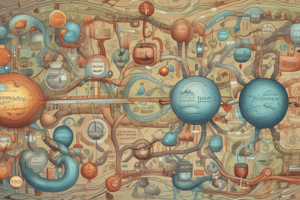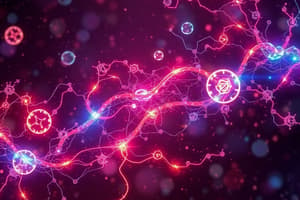Podcast
Questions and Answers
What is a metabolic pathway?
What is a metabolic pathway?
A metabolic pathway is a series of interconnected biochemical reactions that convert a substrate molecule or molecules, step-by-step, through a series of metabolic intermediates, eventually yielding a final product or products.
What are the two major types of metabolic pathways?
What are the two major types of metabolic pathways?
- Oxidative and Reductive
- Anabolic and Catabolic (correct)
- Linear and Cyclic
- Exergonic and Endergonic
Anabolic pathways require energy input.
Anabolic pathways require energy input.
True (A)
Catabolic pathways release energy.
Catabolic pathways release energy.
What is metabolism?
What is metabolism?
What are the two types of metabolic pathways based on structure?
What are the two types of metabolic pathways based on structure?
Which of the following is NOT a macromolecule?
Which of the following is NOT a macromolecule?
What are some examples of macromolecules?
What are some examples of macromolecules?
The human body can survive by only consuming air and solar rays.
The human body can survive by only consuming air and solar rays.
What is the central molecule in metabolism?
What is the central molecule in metabolism?
What is the main function of glucose?
What is the main function of glucose?
Where is glucose absorbed in the body?
Where is glucose absorbed in the body?
What type of transport mechanism is used for glucose absorption?
What type of transport mechanism is used for glucose absorption?
Glucose absorption requires energy.
Glucose absorption requires energy.
Match the following enzymes with their functions in digestion.
Match the following enzymes with their functions in digestion.
What is the role of bile salts in lipid digestion?
What is the role of bile salts in lipid digestion?
What is the function of chylomicrons?
What is the function of chylomicrons?
The body can store unlimited amounts of amino acids.
The body can store unlimited amounts of amino acids.
What is the name of the molecule that is called the "energy currency" of the cell?
What is the name of the molecule that is called the "energy currency" of the cell?
ATP is a large and complex molecule.
ATP is a large and complex molecule.
Where is the energy stored in ATP?
Where is the energy stored in ATP?
What process is used to transfer energy from ATP to other molecules?
What process is used to transfer energy from ATP to other molecules?
What is the name of the process that couples the hydrolysis of ATP with an endergonic reaction?
What is the name of the process that couples the hydrolysis of ATP with an endergonic reaction?
What is the first step in glucose breakdown?
What is the first step in glucose breakdown?
Glycolysis requires oxygen.
Glycolysis requires oxygen.
What is the name of the enzyme that catalyzes the first step of glycolysis?
What is the name of the enzyme that catalyzes the first step of glycolysis?
The second step of glycolysis is also an irreversible reaction.
The second step of glycolysis is also an irreversible reaction.
All carbohydrates enter glycolysis at the same point?
All carbohydrates enter glycolysis at the same point?
What are the two products of glycolysis?
What are the two products of glycolysis?
Pyruvate is the end product of glycolysis.
Pyruvate is the end product of glycolysis.
What is the Cori cycle?
What is the Cori cycle?
The Cori cycle involves both anabolic and catabolic reactions.
The Cori cycle involves both anabolic and catabolic reactions.
What is the function of electron carriers in metabolism?
What is the function of electron carriers in metabolism?
What is the name of a crucial electron carrier in metabolism?
What is the name of a crucial electron carrier in metabolism?
NADH is the oxidized form of NAD.
NADH is the oxidized form of NAD.
Lactate dehydrogenase catalyzes the conversion of pyruvate to lactate.
Lactate dehydrogenase catalyzes the conversion of pyruvate to lactate.
Why is lactate production important during exercise?
Why is lactate production important during exercise?
Lactate is a toxic waste product that is harmful to the body.
Lactate is a toxic waste product that is harmful to the body.
What is the astrocyte-neuron lactate shuttle?
What is the astrocyte-neuron lactate shuttle?
The classical view of neuroenergetics emphasizes the role of astrocytes in providing energy to neurons.
The classical view of neuroenergetics emphasizes the role of astrocytes in providing energy to neurons.
What is the new paradigm shift in neuroenergetics?
What is the new paradigm shift in neuroenergetics?
Galactosemia is caused by a defect in the breakdown of galactose.
Galactosemia is caused by a defect in the breakdown of galactose.
Fructose intolerance is caused by a deficiency in aldolase.
Fructose intolerance is caused by a deficiency in aldolase.
Flashcards
Metabolic Pathway
Metabolic Pathway
A series of biochemical reactions converting substrates step-by-step to final products.
Anabolic Pathway
Anabolic Pathway
A metabolic pathway that synthesizes larger molecules from smaller ones, requiring energy.
Catabolic Pathway
Catabolic Pathway
A metabolic pathway that breaks down larger molecules into smaller ones, releasing energy.
Glycolysis
Glycolysis
Signup and view all the flashcards
ATP (Adenosine Triphosphate)
ATP (Adenosine Triphosphate)
Signup and view all the flashcards
Phosphorylation
Phosphorylation
Signup and view all the flashcards
Electron Carriers
Electron Carriers
Signup and view all the flashcards
NAD/NADH
NAD/NADH
Signup and view all the flashcards
Lipase
Lipase
Signup and view all the flashcards
Chylomicrons
Chylomicrons
Signup and view all the flashcards
Proteins and Digestion
Proteins and Digestion
Signup and view all the flashcards
Amino Acid Transport
Amino Acid Transport
Signup and view all the flashcards
Endergonic Reaction
Endergonic Reaction
Signup and view all the flashcards
Exergonic Reaction
Exergonic Reaction
Signup and view all the flashcards
Homeostatic Neuroenergetics
Homeostatic Neuroenergetics
Signup and view all the flashcards
Cori Cycle
Cori Cycle
Signup and view all the flashcards
Emulsification
Emulsification
Signup and view all the flashcards
Sodium-Potassium Pump
Sodium-Potassium Pump
Signup and view all the flashcards
Facilitated Diffusion
Facilitated Diffusion
Signup and view all the flashcards
Krebs Cycle
Krebs Cycle
Signup and view all the flashcards
Oxidative Phosphorylation
Oxidative Phosphorylation
Signup and view all the flashcards
Gut Microbiota
Gut Microbiota
Signup and view all the flashcards
Bile Salts
Bile Salts
Signup and view all the flashcards
Tripeptides
Tripeptides
Signup and view all the flashcards
Lactate
Lactate
Signup and view all the flashcards
Study Notes
Metabolic Pathways
- Metabolic pathways are a series of interconnected biochemical reactions.
- These reactions convert a substrate molecule, step-by-step, into a final product.
- Metabolic pathways can be linear or cyclic.
Two Major Types of Metabolic Pathways
- Catabolism: This pathway breaks down complex molecules into simpler ones, releasing energy.
- Anabolism: This pathway builds complex molecules from simpler ones, requiring energy.
Metabolism
- Metabolism encompasses all chemical reactions occurring within an organism.
- Catabolism breaks down large molecules into smaller ones, releasing energy.
- Anabolism synthesizes complex molecules from simpler ones, consuming energy.
Cell Metabolism
- Food (macromolecules) are broken down into simpler molecules (micromolecules) during catabolism, releasing energy.
- Energy from catabolism powers anabolism, building biomolecules.
- Heat is released as a byproduct of both processes.
Digestion Pathways
- Digestion breaks down complex carbohydrates, lipids, and proteins into simpler subunits.
- Different enzymes are used for each category (carbohydrates: amylase; lips: lipase; proteins: pepsin, trypsin, chymotrypsin, carboxypeptidase).
- The process occurs in different parts of the digestive tract.
- The final products of digestion are absorbed into the bloodstream.
Glucose Utilization
- Glucose is crucial for cellular energy.
- It is converted to glycogen, a storage form, in various tissues.
- Glucose is oxidized via glycolysis, yielding pyruvate.
- Glucose follows several pathways for various functions (synthesis of structural polymers, pentose phosphate pathway).
ATP (Adenosine Triphosphate)
- ATP is the energy currency of the cell.
- ATP hydrolysis (breaking down ATP) releases energy for work performed inside the cell.
- Cells couple the exergonic reaction of ATP hydrolysis to the endergonic anabolic reactions.
- ATP energy transfer is facilitated through phosphorylation.
Electron Carriers
- Electron carriers facilitate electron transfer in biological systems.
- NAD+ and FAD are examples of important electron carriers derived from B vitamins.
- They temporarily store high-energy electrons and protons (H+).
- NADH carries high-energy electrons.
Glycolysis
- Glycolysis is the initial step in glucose breakdown.
- It is an anaerobic process, meaning it does not require oxygen.
- Glycolysis converts glucose into pyruvate, producing ATP and NADH.
Fate of Pyruvate and NADH
- In anaerobic conditions, pyruvate is converted to lactate or ethanol.
- In aerobic conditions, pyruvate is further oxidized to acetyl-CoA for the citric acid cycle.
- NADH is oxidized to NAD+, transferring energy.
Regulation of Glycolysis
- The rate of glycolysis is controlled by the availability of substrates and the activity of enzymes like hexokinase, phosphofructokinase, and pyruvate kinase.
- Concentrations of fructose-6-phosphate, ATP, and citrate influence enzyme activity
Other Sugars and Glycolysis
- Various sugars, including fructose, lactose, and sucrose, can be converted to glucose-6-phosphate and enter the glycolytic pathway.
Glycolysis Disorders
- Disorders arising from enzyme deficiencies in the glycolytic pathway can lead to problems.
- Examples of specific disorders include galactosemia and fructose intolerance.
Cori Cycle
- Cori cycle is a metabolic pathway where lactate, produced by anaerobic metabolism in tissues, is transported to the liver, where it is converted back into glucose.
Studying That Suits You
Use AI to generate personalized quizzes and flashcards to suit your learning preferences.




